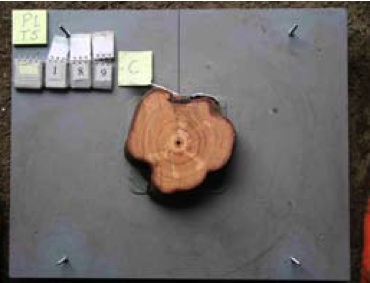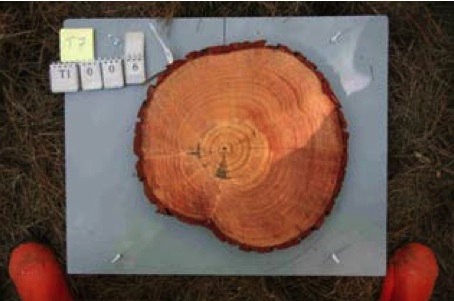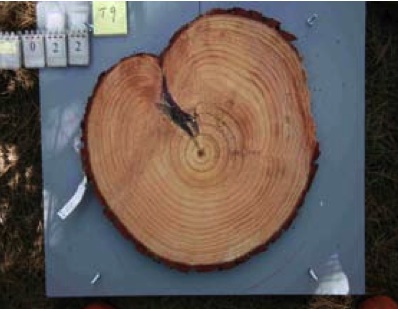PESTS AND DISEASES OF FORESTRY IN NEW ZEALAND
Nectria flute canker
Scion is the leading provider of forest-related knowledge in New Zealand
Formerly known as the Forest Research Institute, Scion has been a leader in research relating to forest health for over 50 years. The Rotorua-based Crown Research Institute continues to provide science that will protect all forests from damage caused by insect pests, pathogens and weeds. The information presented below arises from these research activities.
Forest Health News 180, January 2008.
Nectria flute canker is now well known as a fungal disease affecting Pinus radiata in the southern region of New Zealand, associated with the fungus Nectria fuckeliana. The disease is of major concern as it primarily affects pruned butt logs and is usually associated with pruned branch stubs. Although some trees have active, visible cankers for the remainder of the rotation, other infected trees appear to contain the infection and with increasing age all external evidence may disappear. The fungus is thought to have become established in New Zealand during the 1980s. Mature crops that have developed with infection are now approaching harvest age and methods are required to assist in the identification, segregation, and valuation of affected logs.



Since 2002 there have been substantial efforts to better understand Nectria flute canker in terms of its distribution, and how infection is initiated and progressed, and in identifying practices to minimise negative impacts. The Wood Quality Initiative (WQI) has recently contributed to this research effort and is supporting three projects to examine the affect of Nectria flute canker on wood quality. The field work for all three of these trials was carried out near Dunedin in October 2007 by scientists from Scion and Wood Quality Focus and industry partners in the Nectria Focus Group.
The first two studies compare external disease symptoms with internal wood quality. The first trial focused on young trees in a silvicultural trial established and inoculated with N. fuckeliana in 2003. Thirty trees were selected to cover the full range of disease symptoms from healthy trees to those with severe flute cankers. It is hoped that results can further assist in selection of trees for pruning and in the timing of operations to limit disease severity.
The second trial examined trees of late-rotation age, approaching harvest. Trees in this study were again chosen to cover a range of severity of flute canker symptoms. Data collected in this trial will assist inventory in identifying incidence and severity within the affected plantations. In both trials, trees were destructively sampled to give information on the internal progress of the damage in relation to external flute canker symptoms. Photographs will be used to digitally map the damage caused by Nectria flute canker in and around the defect core with the aim of establishing links between external symptoms and the internal degrade, and also to quantify degrade in wood quality caused by the disease.
The third study examined the relationship between external symptoms of Nectria flute canker and the production of merchantable timber. Trees close to harvest age were classified into three disease severity classes: nil/minor, moderate, and severe. The selected trees were harvested, the butt logs were sawn, and the Kaituna method was used to grade individual logs during processing. Sawn boards were then assessed for grade and defect resulting from Nectria flute canker. The analyses compared timber recovery from those logs and yield information with the original tree classification into disease severity classes.
For the first two studies, the results of the image analyses are needed before any firm conclusions can be drawn; however, observations made during the field work have provided some useful information. In the young trees examined in Study one, stained or symptomatic wood was not observed in the stems of every cankered tree and the fungus N. fuckeliana was isolated from only a few trees. This is true even for some trees with moderately severe external symptoms of Nectria flute canker. In trees examined in Study two, the knotty core in infected trees appeared to be larger than in unaffected trees as it also encompassed flute canker damage. Often, external features with the appearance of minor bark cracks were actually encased bark which ran all the way from the knotty core right through to the outer bark. These appear to have resulted from the closure of narrow flute cankers associated with N. fuckeliana. In contrast, wide depressions that gave the impression of substantial sapwood infection did not always relate to internal defect in terms of sapstain or decay. In these cases the evidence of infected sapwood was usually contained within the knotty core.
Results from the third study indicated that the grading of standing trees into disease severity classes correlates well with the board grade and value of the sawn timber. The small log diameter and a large knotty core in many of the infected logs indicates that trees affected by Nectria flute canker may have to be grown in slightly longer rotations to allow for better timber yield.
This is the first series of studies to examine the wood quality of logs affected by Nectria flute canker and it has provided useful new knowledge about defect distribution within logs and how external appearance may relate to internal wood quality. Preliminary results from these studies have raised some interesting questions about the recovery of trees from Nectria flute canker and has given some pointers for forest inventory.
Further study in this area is warranted, using the pruned logs from trees representing the target harvest age for the region. This will confirm that the external evidence used to successfully identify logs with increasing severity of infection in the current study is applicable for older trees. It will also show how infection develops, if at all, over the final 5–6 years of the rotation.
Anna Hopkins, Margaret Dick, and Lindsay Bulman
This information is intended for general interest only. It is not intended to be a substitute for specific specialist advice on any matter and should not be relied on for that purpose. Scion will not be liable for any direct, indirect, incidental, special, consequential or exemplary damages, loss of profits, or any other intangible losses that result from using the information provided on this site.
(Scion is the trading name of the New Zealand Forest Research Institute Limited.)

 Farm Forestry New Zealand
Farm Forestry New Zealand

